People2.0’s IC Program Enables Risk Reduction, Cost Savings, and Faster Onboarding
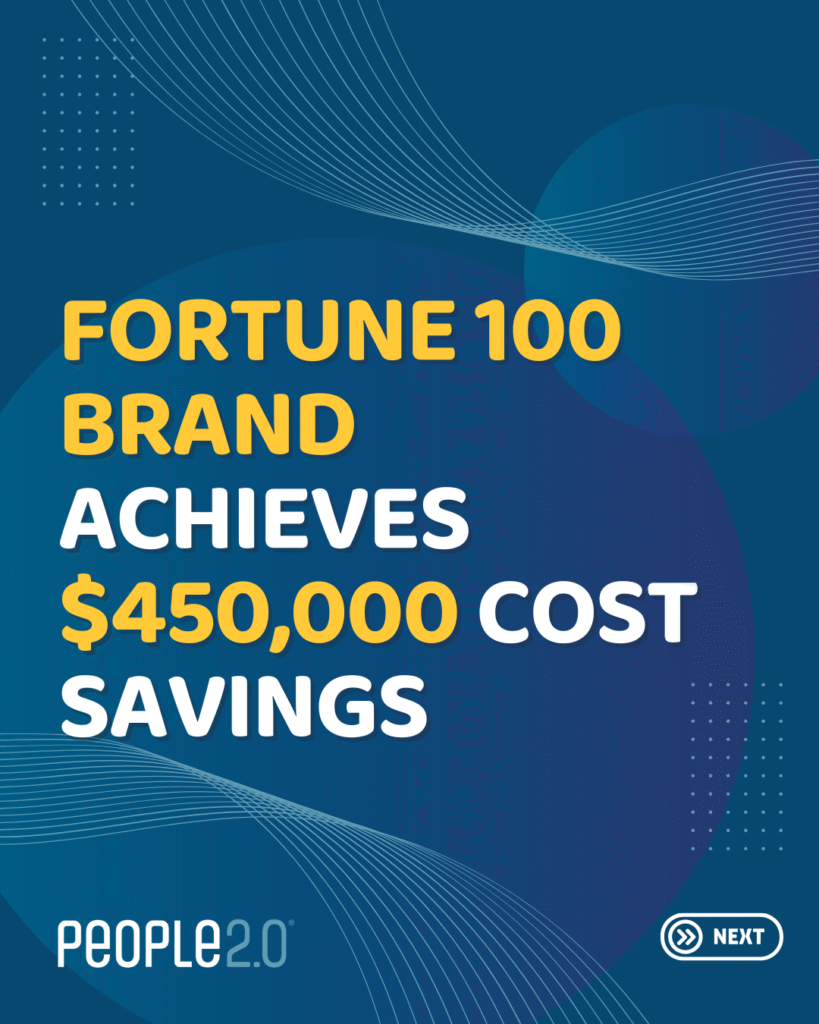
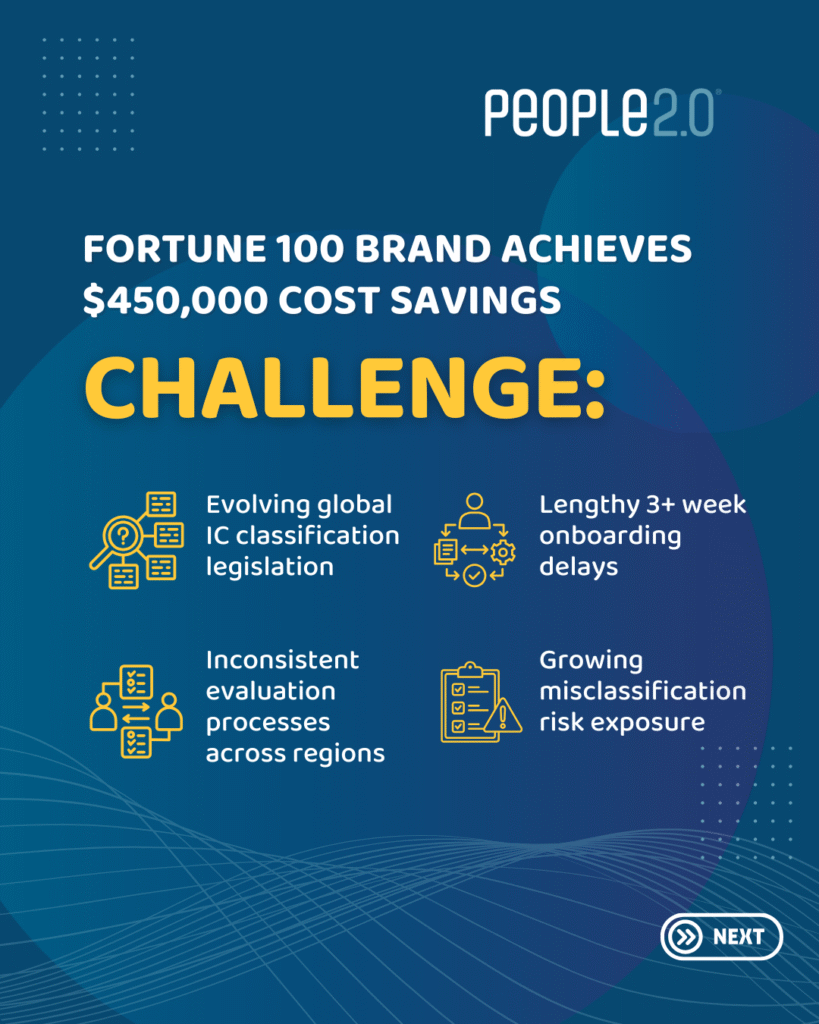
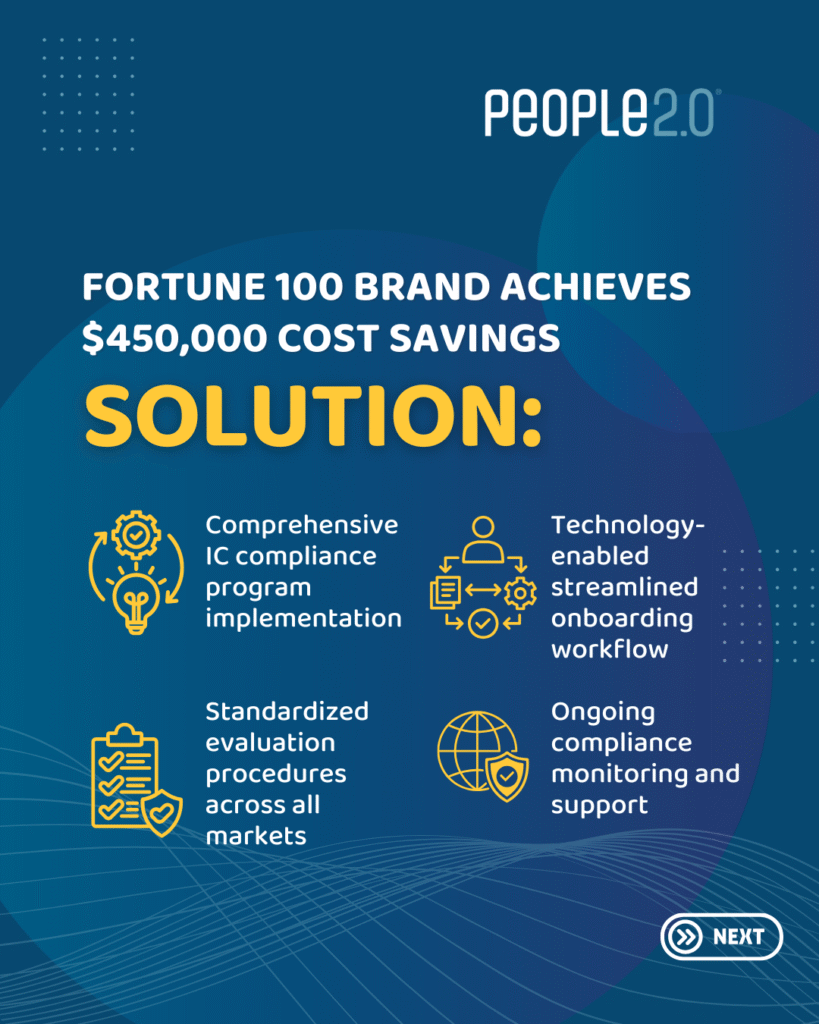
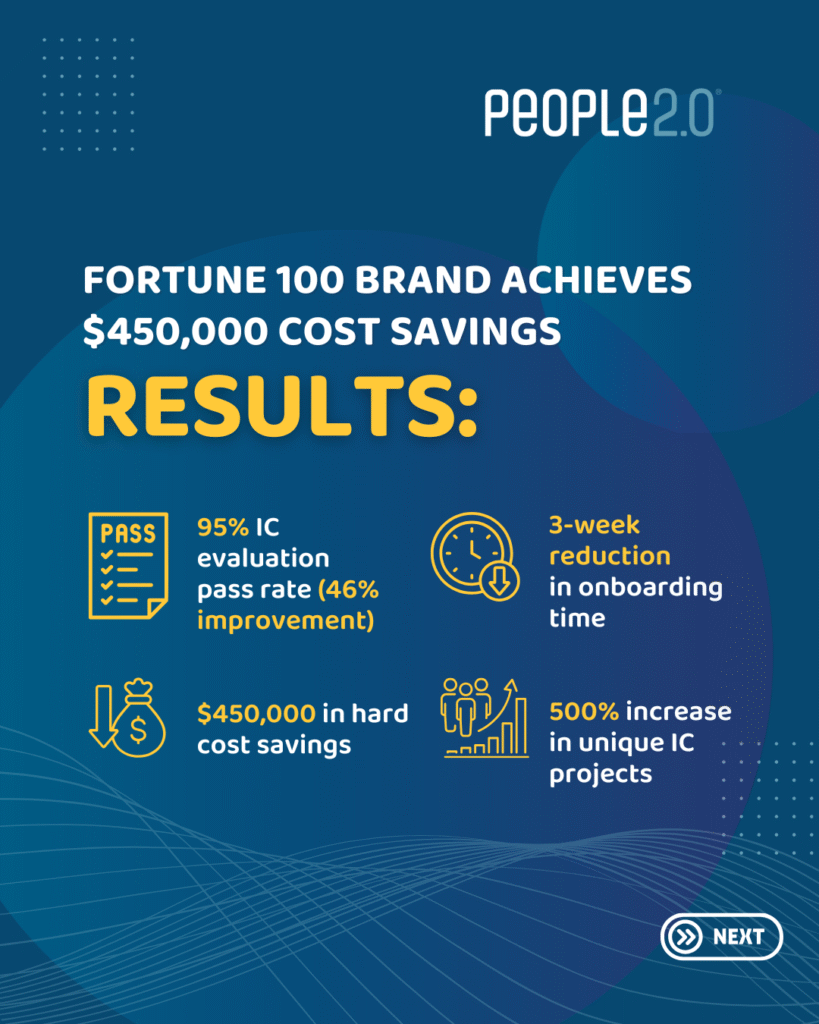
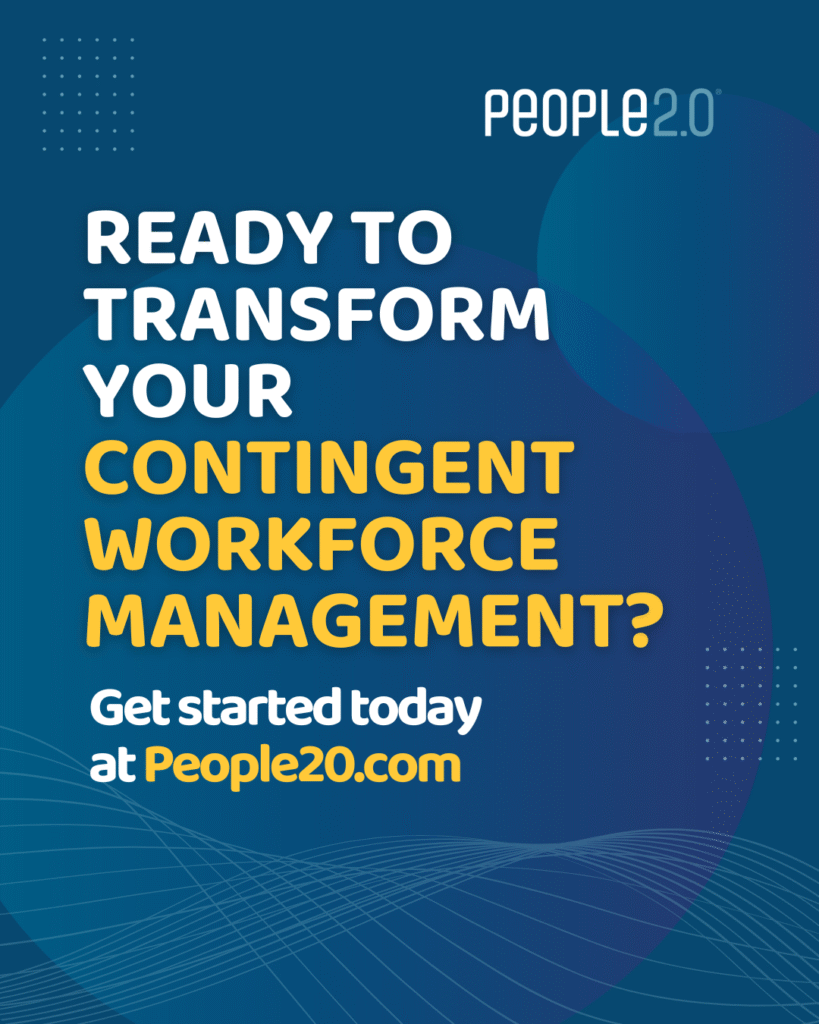
Summary
A Fortune 100 global consumer brand with operations across multiple continents needed to transform their approach to engaging independent contractors due to evolving global legislation and inefficient processes. With a significant presence in markets worldwide, this industry leader faced growing challenges related to worker classification compliance, administrative inefficiencies, and risk management across their contingent workforce program.
People2.0 implemented a comprehensive IC compliance program that ensured proper worker classification while significantly streamlining administrative processes. The solution not only protected the brand from substantial legal and financial risks but also delivered impressive operational efficiencies. By establishing standardized processes, leveraging specialized compliance expertise, and implementing a technology-enabled approach, People2.0 created a solution that addressed both immediate compliance concerns and long-term strategic workforce goals.
Within the first year following the February 2024 launch, the program achieved remarkable results across key performance indicators. The solution delivered a 95% IC pass rate (a 46% improvement over the previous program), reduced onboarding time by three weeks, and generated $450,000 in hard cost savings. These achievements demonstrate the significant value created through the partnership, spanning risk reduction, operational efficiency, and financial performance.
Opportunity
Client Context
The client is a Fortune 100 global consumer brand with operations spanning multiple continents and a workforce distributed across numerous markets worldwide. Their business requires diverse talent across creative, technical, and operational functions to maintain their competitive edge in the highly dynamic consumer goods industry. In recent years, the company had increasingly relied on specialized independent contractors to execute critical project-based work, particularly in areas requiring specialized expertise or creative capabilities.
Prior to engaging with People2.0, the company utilized a decentralized approach to contractor management. This approach had evolved organically as the business expanded globally, resulting in inconsistent practices across regions and business units. While this decentralized model offered flexibility, it created significant challenges as regulatory scrutiny of worker classification intensified across global markets.
Key Challenges
The company faced two interconnected categories of challenges that threatened both their operational effectiveness and compliance posture. First, compliance risks had escalated substantially due to the evolving worker classification legislation across multiple jurisdictions where they operated. Each region presented unique regulatory requirements, creating a complex compliance landscape that was difficult to navigate with their existing resources. The potential consequences of misclassification were severe, including substantial financial penalties, negative brand impact, and damaged relationships with their contractor community. Internal reviews had revealed inconsistent evaluation and documentation procedures that created unnecessary vulnerability.
Secondly, operational inefficiencies were hampering the company’s ability to quickly deploy talent where needed. The existing contractor engagement process involved lengthy onboarding procedures that often delayed project starts by several weeks, creating frustration for both business managers and contractors themselves. Management lacked comprehensive visibility into their contingent workforce utilization, making strategic workforce planning difficult. The fragmented approach to managing independent contractors also resulted in duplicated efforts, inconsistent experiences for contractors, and missed opportunities for program optimization.
Solution Requirements
After a thorough assessment of their contractor engagement practices, the company established several critical requirements for a successful solution. The primary requirement was ensuring compliance with local laws and regulations across all global markets where they engaged independent contractors. This compliance needed to be built into standardized processes that would accelerate the contractor evaluation process while maintaining rigorous standards.
The solution needed to significantly improve the user experience for both internal managers and contractors, creating a streamlined pathway from identification of talent need to productive engagement. A unified system for managing the contingent workforce would provide the visibility and control needed for effective program management while maintaining appropriate flexibility for business-specific requirements. Finally, the solution needed to deliver measurable cost savings and risk reduction, demonstrating clear return on investment through both hard and soft dollar savings.
Solution
Why People2.0
After evaluating several potential partners, the company selected People2.0 based on several distinctive capabilities that aligned with their complex requirements. People2.0 offered comprehensive global compliance expertise with deep understanding of worker classification regulations across the diverse markets where the company operated. This expertise was complemented by a proven IC evaluation methodology that had been refined through implementations with other multinational organizations facing similar challenges.
The scalability of People2.0’s solution was particularly important given the company’s global footprint and growth trajectory. The solution provided consistent application of compliance standards across geographies while accommodating necessary local variations in regulatory requirements. Additionally, People2.0’s technology-enabled approach promised to streamline processes that had previously been highly manual and time-consuming, creating efficiencies while improving compliance outcomes.
Implementation Process
The implementation followed a carefully structured, phased approach designed to minimize disruption while rapidly addressing the most critical compliance and operational gaps. The initial phase began with a comprehensive assessment of current contractor engagement practices across the organization. This diagnostic process revealed significant variations in how contractor relationships were evaluated, documented, and managed across different business units and regions. People2.0 worked collaboratively with the company’s legal, HR, and procurement teams to identify specific compliance requirements by region, ensuring the solution would address all applicable regulations. This foundational work informed the development of a customized program framework that would serve as the blueprint for implementation.
The deployment phase focused on implementing standardized evaluation procedures that would ensure consistent application of compliance standards. These procedures were designed to balance rigorous compliance with practical business needs, providing clear guidance while maintaining appropriate flexibility. Significant effort was dedicated to integration with existing systems, including the company’s vendor management and procurement platforms, to create a seamless experience for users. A comprehensive rollout of manager training and support resources ensured stakeholders understood both the importance of compliance and practical operation of the new program, building organizational buy-in during this critical transition.
Following initial deployment, the program entered an optimization phase characterized by continuous improvement based on feedback and performance metrics. The solution expanded to additional business units beyond the initial scope as success became evident. People2.0 worked with the company to refine processes and increase efficiency while maintaining compliance integrity, demonstrating ongoing commitment to the program’s success beyond implementation.
Key Features
The implemented solution incorporated several key features designed to address the company’s specific challenges. At its core was a rigorous compliance evaluation process that assessed each contractor relationship against applicable local regulatory standards. This evaluation used a sophisticated, multi-factor analysis tailored to each jurisdiction’s specific requirements for independent contractor status. The result was a reliable, defensible determination that protected both the company and the contractors.
A streamlined onboarding workflow dramatically simplified the process for independent contractors, reducing friction and time-to-productivity. The centralized management system provided comprehensive visibility into all IC engagements, enabling effective program governance and strategic workforce planning. Comprehensive verification procedures for background checks and tax compliance ensured all necessary due diligence was completed prior to engagement, while ongoing compliance monitoring throughout the engagement lifecycle addressed the dynamic nature of contractor relationships and evolving regulatory requirements.
Results
Program Impact at a Glance
The implementation of People2.0’s IC compliance solution delivered transformative results across multiple dimensions, demonstrating that enhanced compliance can coexist with operational efficiency and cost savings:
Compliance Excellence
- 95% IC evaluation pass rate (46% increase from previous program)
- Dramatic reduction in misclassification risk exposure
- Consistent, defensible compliance processes across all engagements
Operational Efficiency
- 3-week reduction in evaluation and onboarding timeline
- $450,000 in hard dollar cost savings during first year
- 500% increase in unique IC projects compared to previous program
Program Adoption
- 141 different managers actively utilizing the solution
- 21+ distinct job functions successfully supported
- Expanded beyond initial scope to become the organization’s standard
This dramatic improvement in IC evaluation pass rates significantly reduced the company’s risk exposure while creating a more predictable engagement process for business users. The accelerated timeline created substantial business value by enabling faster deployment of critical talent resources and improving the contractor experience. Most importantly, these improvements demonstrated that rigorous compliance and operational efficiency can be achieved simultaneously with the right strategic approach.
Transformative Benefits
Beyond the measurable metrics, the program delivered substantial qualitative benefits that transformed the company’s approach to independent contractor management:
Risk Mitigation: The most strategically significant outcome was the dramatically reduced risk exposure related to worker misclassification. By implementing consistent, defensible compliance processes across all engagements, the company substantially decreased potential liability that could have resulted in financial penalties, reputation damage, and operational disruption.
Enhanced User Experience: The program created an improved manager experience through a simplified process for engaging independent contractors. What had previously been a complex, often frustrating experience became a streamlined, predictable process that business leaders could navigate with confidence. This improvement extended to the contractor experience as well, with faster onboarding and more reliable payment processing enhancing the company’s reputation within the contractor community.
Strategic Workforce Visibility: The centralized management approach provided greater visibility into contingent workforce utilization, enabling data-driven decisions about resource allocation and strategic workforce planning. Perhaps most importantly, the program established standardized quality through consistent compliance standards across all engagements, creating a foundation of excellence that could be maintained and built upon over time.
Client Satisfaction
The program has been embraced across the organization, expanding well beyond its initial scope to become the standard for independent contractor engagement. Positive feedback from business leaders, contractors, and compliance stakeholders has reinforced the program’s value proposition. The company continues to collaborate closely with People2.0 to evolve the program in response to emerging business challenges and changing regulatory requirements, demonstrating the partnership’s strategic importance and long-term orientation.
Future Outlook
Building on the program’s initial success, the partnership is expanding to encompass additional global regions where the company operates, further extending the compliance and efficiency benefits. Plans include the integration of advanced analytics capabilities for workforce planning, enabling more sophisticated strategic workforce decisions based on comprehensive program data. The partnership is also exploring the development of enhanced contractor sourcing capabilities that would streamline the identification and engagement of qualified independent professionals.
Continuous improvement remains a core focus, with ongoing efforts to further optimize cost structures and operational processes. As the program matures, both organizations are committed to identifying new opportunities to create value through the contingent workforce program, ensuring it remains aligned with evolving business needs and regulatory requirements.
Ready to Transform Your Contingent Workforce Program?
Is your organization facing similar challenges with independent contractor compliance? You’re not alone. Many global enterprises struggle to balance compliance requirements with operational efficiency when engaging independent talent.
People2.0 has helped leading organizations across industries achieve what was once thought impossible: enhancing compliance while simultaneously reducing costs and accelerating processes. Our clients enjoy peace of mind knowing their contractor relationships are properly structured, while their business users benefit from streamlined processes that get talent working faster.
Don’t wait for a compliance issue to force reactive changes. Take proactive control of your contingent workforce strategy today.



